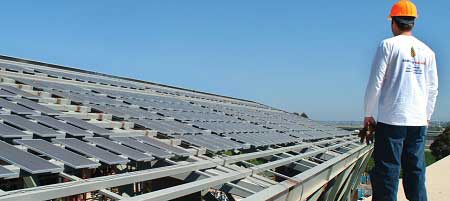The looming step down of the solar federal investment tax credit (ITC) from 30% to 10% for larger projects at the end of 2016 is consuming the solar industry. There isn’t some cataclysmic shift that will happen in 2017; it’s happening now. If projects aren’t lined up with a builder by the end of 2015, the project will likely have very serious pain points and, in some instances, won’t get finished.
Solar developers are in an all-out sprint to get deals to a shovel-ready status with an EPC firm within the next few months. At this point, to qualify for the current ITC, projects must be operational by Dec. 31, 2016.
For now, industry-leading asset owners, developers and EPCs are preparing for the worst by securing their contracts, counterparties, suppliers and strategic partners now, as opposed to later.
Utility solar project developers have had to navigate the market pressures resulting from the ITC step down for a while. But now that it’s imminent, there is less room for time delays, false starts or mistakes. There are four key factors defining a project’s success in making the ITC cutoff: interconnection timelines, access to labor, tax equity availability and permitting.
Interconnection
Interconnection can be a rather long and drawn-out process depending on the utility, study type and overall project size. To ensure a project reaches permission to operate (PTO) in time to make the ITC cut-off, it’s essential the project is far enough along in the study process to get an interconnection agreement (IA) tendered before the end of 2016.
In addition, once there is an IA in place, the engineering and construction timelines associated with interconnection facilities need to provide ample time for testing and commissioning. This will not only require project owners and developers to post capital in the form of security deposits that get spent as construction moves along, but they’ll also need to release the utility to commence construction, drawing down and spending the capital. The decision to authorize the utility to do their work is being made earlier than usual in an effort to make the ITC cut-off.
In areas of the country where hundreds of megawatts of solar is being installed, the industry is likely to encounter testing and commissioning delays with the local utility or independent system operators. For those in the business of mitigating their ITC deadline risk, targeting PTO well in advance of the end of 2016 should be done to accommodate the likely delays from your local utility.
Access to labor
Analyst firm IHS reported in early June that U.S. developers had a pipeline of 32 GW of utility-scale PV to complete before the ITC deadline—25% of the pipeline was already under construction. According to GTM Research, an indicator of utility PV’s aggressive growth trajectory in 2015 and 2016 has been the uptick in construction activity, with total capacity under construction now greater than 4 GW for the first time in two years.
All this activity means that companies, public agencies, technology providers, contractors and financiers will be constrained making sure they can move these projects across the finish line. As a result, the access to high quality materials and qualified manpower will be challenging. Choosing a dependable EPC with technology supply contracts in place and solid relationships with local subcontractors is a key consideration in mitigating this risk.
The rebound of the broader economy and increased construction projects is another limiting factor. Many solar electrical subcontractors and local laborers also work on more general forms of construction projects, and with the economy improving, this is bound to become an additional constraint on project timelines.
A developer’s ability to establish certainty around needed resources is an essential component of securing competitive market financing. Financiers want to partner with developers that have a holistic approach and long-term view, not ones that are in it for the short-term.
Tax equity
Tax equity investors can make up a substantial part of the capital stake of a solar project, and they often take an ownership role and receive a return based on cash flow from the asset and federal and (in some instances) state income tax benefits. Tax equity investors are usually large tax paying financial entities such as banks, insurance companies and utility affiliates that use these investments to reduce current and future tax liabilities. A tax equity investor not only monetizes the ITC, but also benefits from accelerated depreciation.
Given the current environment consisting of more projects in the pipeline than there is tax equity appetite, tax equity investors will be more selective over the next 18 months than in the past. They will shift to higher quality, more bankable projects that have products and resources lined up. To secure your place at the top of the list with this tough-to-attain investor class, make sure you have an ideal clean project to finance, or expect this part to be more difficult than history has shown—which is surprisingly hard to believe.
Permitting
Similar to interconnection, permitting can be challenging and riddled with delays and complications. It’s essential to assume things won’t always break your way, and make sure to get started with the permitting process as early as possible. Go into the local agency offices and sit down with the person responsible for the relevant permit to discuss any concerns you have up front. In many cases establishing a basic relationship can help reduce the inherent bureaucracy associated with this development milestone.
Developers must also manage potential state or federal permitting items. If the project is near a wetland or biological resource, it will likely trigger additional time-intensive permitting requirements. While there may be an option to defer time-intensive public infrastructure upgrades (road improvements, landscaping, etc.) until after PTO, when it comes to federal and state-level environmental permitting, it needs to be done prior to construction commencement.
Be sure to identify areas of concern now; stay in front of them and don’t be afraid to start the project specific permitting process early, as there is bound to be an increase in activity at both the state and federal level—which they’re likely not staffed to handle.
Looking Ahead
Given all of these top-level considerations, the market will begin to see more collaboration between developers, EPCs and project owners with the common goal of getting projects built before the end of 2016. There is less room for error and many developers aren’t proficient in dealing with every aspect quickly enough to keep the project moving forward at the needed pace. Market participants will seek out others in the industry that have expertise in an area that they might be lacking to get the project over the ITC finish line.
The sunset of the ITC is also expected to bring more consolidation in the market. As development of utility projects start to slow down, market participants will either merge, vanish or figure out the next big thing. Stay in front of the curve, put your capital to work and don’t take a vacation. Every day from here on out could make or break your deal.
Published with permission from the original article written by Aaron Halimi, director of utility project development at Borrego Solar, and edited for publication on SOLAR POWER WORLD ONLINE by Kelly Pickerel.















Comments